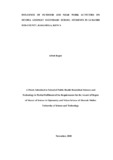| dc.description.abstract | The prevalence of myopia has disturbingly escalated globally with an estimationof up to 2.56 billion cases by the end of 2020. Almost halfof the earth'sinhabitants are estimatedto be myopic bythe year 2050,while a fifth of the world’s population will have its attendant vision threatening conditions bythen. In Kenya, the prevalence has risen from 6% to 15% in urban settings. Myopiais saidto be the foremost cause of visual impairment in Kenya contributing to atotal of about 59.5%of the visual impairment. Till date,consensuson the exact aetiologyand risk factors for myopia is notclearly documented. However, increased near-related activities and littleoutdoor time have been increasingly associated with myopia, even thoughthe indicationis not entirely reliable. This study’saimwas toevaluatethe influence of near work and outdoor activities on myopia amongst randomly selected secondary school studentsfrom Lurambisub-county ofKakamega County in Kenya. Thespecific objectives wereto determine;the prevalenceof myopia, sociodemographic distributionof myopia, level of outdoor and near work activitiesamongst myopic and non-myopic studentsas well as toestablishthe relationshipbetweenoutdoor activities, near workactivities and myopia. The study adopted an analyticalcross-sectional study design. By the use of multi-stage sampling technique, through random selection from a population of 7,400 secondary school students in Lurambi Sub-County, 733 participants were selected and classified clinically as myopic and non-myopic. Those who met the study’s inclusion criteria were taken through standard optometric vision protocol todetermine individuals with myopia,while pre-tested near-tasks and outdoor-time questionnaireswereadministered to boththemyopicand non-myopic. The prevalence of myopia was found to be 7.5% and maleswere more myopic than females. It was established that myopia was more prevalent in 16-year-oldsand intheurban areas. 431(63.6%)and27(49.1%)of non-myopic and myopic students respectively reportedto takingpart in sporting and outdoor activities,while 222(32.7%) of non-myopic and 46(83.7%) of myopes reported to not spending plenty of time outdoors. 40(72.8%) of myopes reported to having extra revision classes often, out of which30(54.5%) reported to having 6 classes. 38(69.1%) of myopesagreed that when reading they always held theirbooks closer to their eyes witha proximity of 10 to 25cm. A logistic regression analysis showed that there was no significant influence of outdoor activities on having myopia,2(8)=9.75, p=0.059). While there was significant influence of near-work activities on having myopia (χ2(14)= 44.122, p=0.005,having extra/revision classes dailyor duringweekends increased the probability of having myopia OR,3.983; 95% CI, [1.78-8.89];p=0.001. To add on, having more hours for extra classes or revision increased probability of myopia OR,2.017; 95% CI, [1.39-6.50];p= 0.005. On the other hand, reducing the number of hours spent reading newspapers reducedprobability of having myopia by 0.88. In conclusion,the study reported an associationbetween near-related activities and having myopia. Near related activities aremodifiable factorshence they canbe modified in schools to control for the myopia development and progression.This,in essence,is a cost-effective interventional strategyto control myopia. | en_US |

